

At a Slaughterhouse, Some Things Never Die - Who Kills, Who Cuts, Who Bosses Can Depend on Race. Sokushinbutsu. Sokushinbutsu (即身仏?)

Refers to a practice of Buddhist monks observing austerity to the point of death and mummification. This process of self-mummification was mainly practiced in Yamagata in Northern Japan between the 11th and 19th century, by members of the Japanese Vajrayana school of Buddhism called Shingon ("True Word"). Heist: Who Stole the American Dream? Heist: Who Stole the American Dream?
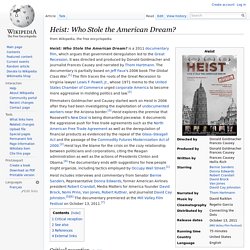
Is a 2011 documentary film, which argues that government deregulation led to the Great Recession. It was directed and produced by Donald Goldmacher and journalist Frances Causey and narrated by Thom Hartmann. The documentary is partially based on Jeff Faux's 2006 book The Global Class War.[1] The film traces the roots of the Great Recession to Virginia lawyer Lewis F. Powell, Jr., whose 1971 memo to the United States Chamber of Commerce urged corporate America to become more aggressive in molding politics and law.[2] Filmmakers Goldmacher and Causey started work on Heist in 2006 after they had been investigating the exploitation of undocumented workers near the Arizona border.[3] Heist explores the premise that Roosevelt's New Deal is being dismantled piecewise.
Critical reception[edit] See also[edit] Who Stole the American Dream? References[edit] External links[edit] Official website. Literature, Writing & Anthropology. What is the work that stories do?
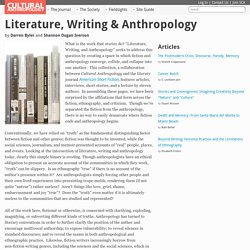
“Literature, Writing, and Anthropology” seeks to address this question by creating a space in which fiction and anthropology converge, collide, and collapse into one another. This collection, a collaboration between Cultural Anthropology and the literary journal American Short Fiction, features articles, interviews, short stories, and a lecture by eleven authors. Sustainable spatial rebalancing for Northern England: alternative models and future scenarios at University of Manchester. This full time, three year PhD studentship, starting in September 2015, is funded by the ESRC CASE studentship scheme.

CASE studentships involve a PhD student working in partnership with an organisation to undertake a study designed to be relevant to the organisation. This creates an invaluable opportunity for students to undertake a PhD that bridges academic and professional concerns, having a direct impact in a professional context whilst also producing a PhD thesis. Sustainable spatial rebalancing for Northern England: alternative models and future scenarios at University of Manchester. Edith Cowan University - Academia.edu. Hpa-an Situation Update: T'Nay Hsah Township, November to December 2012. Situation Update | T'Nay Hsah Township, Hpa-an District (November to December 2012) The following situation update was written by a community member in Papun District who has been trained by KHRG to monitor human rights conditions.
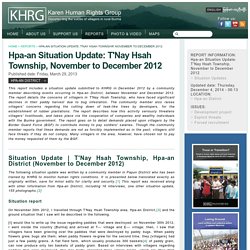
It is presented below translated exactly as originally written, save for minor edits for clarity and security.[1] This report was received along with other information from Hpa-an District, including 16 interviews, one other situation update, 155 photographs.[2] Situation report. Online Burma Library > Main Library > Forests and forest peoples (being reconstructed) How Food Innovation Helped Spur Advances in Nautical Technology. Burma Land Grab Victims Turn to Black Magic. Farmers in Mingaladon Township, Rangoon Division, protest against land grabs in 2012.

Myanmar Craftsmen and Toymakers Struggle to Survive in Sagaing. A child looks at the papier marche toys for sale at the Kaung Mu Daw Pagoda stairway.
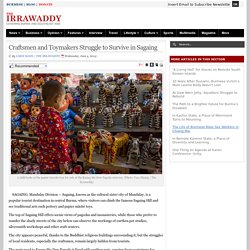
(Photo: Teza Hlaing / The Irrawaddy) Mogok: a misty hidden Shangri-La in the forested hills. By Stuart Alan Becker | Friday, 19 September 2014.
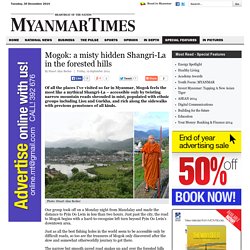
In Mandalay, a Road to Ruin for City’s Sculptors. Half-crafted statues of various sizes are assembled in front of workshops in Kyauk Sit Tan, located near the western entrance of the Maha Myat Muni Pagoda in Mandalay.

(Photo: Zarni Mann / The Irrawaddy) MANDALAY — Tropical winds carry white dust through the air, welcoming visitors who stroll along the lane of Mandalay’s marble-carving epicenter. The dust covers craftsmen who work with electric drills here on Kyauk Sit Tan, the stone sculpture lane near the west entrance of the city’s famous Maha Myat Muni Pagoda, while marble statues of various sizes line workshop after workshop. Mandalay is widely known as the heart of Burmese culture, drawing tourism interest in its traditional craftsmanship. Mandalay’s Handmade Gold Leaf Industry Under Threat. Men work with hammers at a gold leaf workshop in Mandalay.
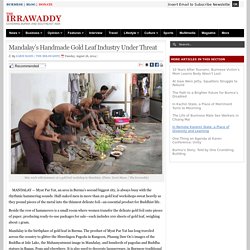
(Photo: Zarni Mann / The Irrawaddy) MANDALAY — Myat Par Yat, an area in Burma’s second biggest city, is always busy with the rhythmic hammering sounds. Half-naked men in more than 20 gold leaf workshops sweat heavily as they pound pieces of the metal into the thinnest delicate foil—an essential product for Buddhist life. Beside the row of hammerers is a small room where women transfer the delicate gold foil onto pieces of paper, producing ready-to-use packages for sale—each includes 100 sheets of gold leaf, weighing about 1 gram. A Thousand Reasons: Beauty From Destruction in Myanmar – Part I. (The Tragedy of Cyclone Nargis) I've had just enough time to... see wood carved from fallen trees A typical farmhouse in the Irrawaddy Delta, Myanmar In the last week of April, 2008, a low pressure system built up in the Bay of Bengal. On April 27, the Indian Meteorological Department declared that it has strengthened to a tropical depression.
The depression moved north-northwest and was upgraded to the cyclone, Nargis on April 28. Equivalent to a category 1 hurricane, it picked up speed and intensity to wind of 100 mph making it to a category 2 equivalent on April 29.